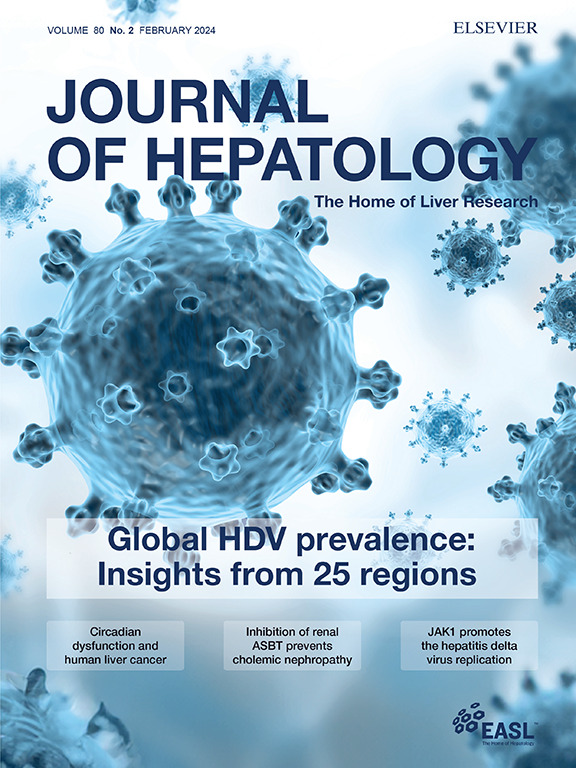人戊型肝炎疫苗引起的抗体对大鼠戊型肝炎病毒具有跨属保护作用
IF 33
1区 医学
Q1 GASTROENTEROLOGY & HEPATOLOGY
引用次数: 0
摘要
背景,乙型肝炎病毒(bHEV),也被称为戊型肝炎病毒(HEV),包括8种基因型,其中5种感染人类。大鼠是鼠型罗卡疱疹病毒基因型1 (HEV-r-1)的天然宿主;鼠戊肝病毒;rHEV),最近与病毒性肝炎有关。尽管bHEV和rHEV之间存在抗原差异,但关于共享保护性抗体的研究仍然很少。方法采用抗体酶联免疫吸附法分析bHEV和rHEV的多克隆和单克隆抗体反应。六种强效bhev诱导的交叉反应抗体在大鼠体内预防rHEV感染的效果通过攻毒试验进行了评估。冷冻电镜(Cryo-EM)分析了六种抗体不同保护效果的结构基础。通过将纯化的HEV-b-1和HEV-r-1病毒粒子分别与每种抗体反应来评估这些抗体的病毒裂解能力。结果我们确定了bHEV感染和疫苗接种的抗体对rHEV具有有限的交叉反应性,并在E2s结构域内鉴定了两个交叉反应性抗原位点。结构分析和动物挑战研究确定了针对抗原位点1的强效交叉反应抗体,表明其对rHEV的预防作用。相反,发现识别抗原位点2的抗体有助于bHEV的病毒裂解,而不是rHEV。结论这些发现强调了抗原位点1在设计广谱疫苗和治疗方法以减轻不同HEV基因型对人类健康的影响中的重要性。影响和影响甲型h1n1流感病毒对人类的溢出构成了前所未有的威胁。rHEV和bHEV之间的显著抗原差异可能加剧病毒性肝炎的影响。我们的研究表明,交叉反应的人抗体可以提供抗rHEV感染的保护。针对抗原位点1的交叉保护抗体可用于制定预防rHEV感染的实用策略。本文章由计算机程序翻译,如有差异,请以英文原文为准。

Antibodies elicited by hepatitis E vaccination in humans confer cross-genus protection against rat hepatitis E virus
Background & Aims
Paslahepevirus balayani (bHEV), also known as hepatitis E virus (HEV), encompasses eight genotypes, five of which infect humans. Rats are natural reservoirs of Rocahepevirus ratti genotype 1 (HEV-r-1; rat HEV; rHEV), which has recently been implicated in viral hepatitis. Despite the antigenic divergence between bHEV and rHEV, studies on shared protective antibodies remain rare.Methods
Polyclonal and monoclonal antibody responses against bHEV and rHEV were analyzed using antibody enzyme-linked immunosorbent assays. The efficacy of six potent bHEV-elicited cross-reactive antibodies in preventing rHEV infection was evaluated via challenge assays in rats. Cryo-EM was performed to assess the structural basis for the differential protective efficacy of the six antibodies. The viral lysis ability of these antibodies was assessed by separately reacting purified HEV-b-1 and HEV-r-1 virions with each antibody.Results
We determined that antibody responses to bHEV infection and vaccination possess limited cross-reactivity to rHEV and identified two cross-reactive antigenic sites within the E2s domain. Structural analysis and animal challenge studies pinpointed potent cross-reactive antibodies targeting antigenic site 1, indicating its prophylactic efficacy against rHEV. Conversely, antibodies recognizing antigenic site 2 were found to facilitate viral lysis of bHEV but not rHEV.Conclusions
These findings underscore the importance of antigenic site 1 in the design of broad-spectrum vaccines and therapeutics to mitigate the impact of diverse HEV genotypes on human health.Impact and implications
rHEV spillover to humans represents an unprecedented threat. Significant antigenic differences between rHEV and bHEV may exacerbate the impact of viral hepatitis. Our study reveals that cross-reactive human antibodies can offer protection against rHEV infection. Cross-protective antibodies targeting antigenic site 1 can be used to inform the development of practical strategies for preventing rHEV infection.求助全文
通过发布文献求助,成功后即可免费获取论文全文。
去求助
来源期刊

Journal of Hepatology
医学-胃肠肝病学
CiteScore
46.10
自引率
4.30%
发文量
2325
审稿时长
30 days
期刊介绍:
The Journal of Hepatology is the official publication of the European Association for the Study of the Liver (EASL). It is dedicated to presenting clinical and basic research in the field of hepatology through original papers, reviews, case reports, and letters to the Editor. The Journal is published in English and may consider supplements that pass an editorial review.
 求助内容:
求助内容: 应助结果提醒方式:
应助结果提醒方式:


